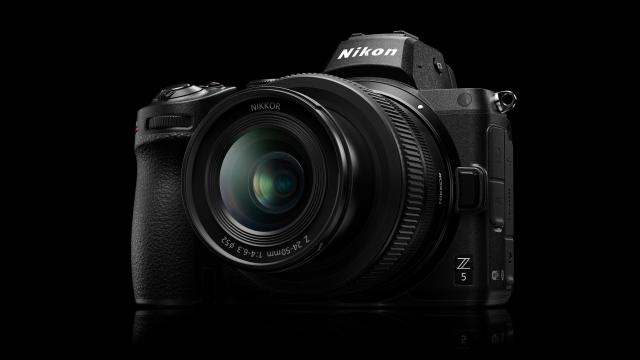After fully committing to the world of mirrorless cameras with the Z6 and Z7, Nikon has been expanding its portfolio with more affordable options like the Nikon Z50 and now this: the Nikon Z5.
Starting at $US1,400 ($1,967) (body only) or $US1,700 ($2,388) with Nikon’s new 24-50mm f/4-6.3 lens, the Z5 is priced between the $US860 ($1,208) Z50 (body only) and its more expensive sibling, the $US1,800 ($2,529) Z6 (body only). However, unlike the Z50, which uses an APS-C-sized sensor, the Z5 features a full-frame 24-MP sensor that has the same resolution as what you get in the Nikon Z6, but lacks the backside-illuminated sensor tech used in the Z6.
The Z5 also shares the same Expeed 6 image processor used in the Z6 and Z7, along with a similar number of focus points (273) and support for face, animal, and eye autofocus. However, aside from video, the biggest area where the Z5 falls short compared to the Z6/Z7 is on shooting speeds, with the Z5 topping out at 4.5 FPS with AF and autoexposure enabled. That’s a bit slower than Canon’s entry-level full frame mirrorless competitor, the EOS RP, which can hit continuous shooting rates of 5 FPS, and half the speed (or less) of what you get from the Z6 (12 FPS), Z7 (9 FPS), or even APS-C rivals like Sony’s A6600 (11 FPS).
Another nice feature the Z5 shares with the Z6 and Z7 is its use of five-axis in-body image stabilisation, which, when paired with Nikon’s growing line of Z lenses, should offer some pretty serious shake reduction. And for anyone who still wasn’t happy about Nikon giving the Z6/Z7 just a single XQD card slot, the Z5 changes that by including support for two UHS II SD card slots instead.
As for video, while the Z5 can record 4K video at 30 FPS, the Z5 doesn’t use its entire sensor to do it, and instead relies on a 1.7x crop. If you want a full-frame readout, you’ll have to switch to 1080P video, which caps out at 60 FPS.
Physically, the Z5 is almost exactly the same size and weight as the Z6, though instead of featuring a magnesium alloy frame, the Z5 has a plastic polycarbonate body, which thankfully still has the same sort of weather sealing you get on the Z6 and Z7. That means the biggest difference in design between the Z5 and Z6 is the Z5’s lack of a secondary top-mounted display, which is helpful for checking things like camera settings, shot count, and battery life at a glance.
[referenced url=”https://gizmodo.com.au/2020/05/sonys-video-focused-zv-1-wants-to-help-you-become-a-youtube-star/” thumb=”https://gizmodo.com.au/wp-content/uploads/2020/05/27/dzgiksblbtomt0lezanj-300×169.jpg” title=”Sony’s Video-Focused ZV-1 Wants to Help You Become a YouTube Star” excerpt=”DSLRs and mirrorless cameras have become popular tools for YouTubers wanting their videos to look more professional, but for inexperienced shooters, the complexity of those cameras can be overwhelming. Sony’s new ZV-1 aims to flatten the learning curve with streamlined features that promise to help make aspiring YouTube stars look…”]
Around back, the Z5 sports both a 3.69 million dot OLED electronic viewfinder and a 3.2-inch LCD touchscreen, though sadly, the Z5’s rear display only tilts and doesn’t feature full 360-degree articulation like you get on a growing number of mirrorless cameras. Personally, I think this is kind of a mistake, because having a rear display that can flip around makes it so much easier to shoot self portraits or vlog-style videos, which seems like something people who might be interested in the Z5 would want to do. Heck, with so many kids hoping to become YouTubers, competitors like Sony and others are making cameras specifically designed to support that vlog life, which makes it feel a bit weird that Nikon hasn’t really embraced this trend yet.
Still, for anyone looking for a cheaper way to get into a full-frame mirrorless camera, the Z5 looks like a worthy contender to Canon’s EOS-RP. The Nikon Z5 is slated to go on sale in the U.S. sometime in August.
Editor’s Note:Â Stay tuned for Australian pricing and availability.
